Optimized Green Extraction of Polyphenols from Cassia javanica L. Petals for Their Application in Sunflower Oil: Anticancer and Antioxidant Properties
Abstract
1. Introduction
2. Results and Discussion
2.1. Total Phenolic Content of Cassia javanica Petals Powder and Ethanol Concentration
2.2. Optimization of Ultrasound Parameters for Assisted Extraction of TPC
2.3. Supercritical Fluid Carbon Dioxide (SCF-CO2) Assisted Extraction
2.4. The Effect of Different Extraction Methods on the Identification of the Phenolic Compounds of Cassia javanica Petals
2.5. Cytotoxic Effect on Human Cell Lines for All Treated Samples
2.6. β-Carotene/linoleic Acid and DPPH Assay of All Treated Samples
2.7. Evaluation of Sunflower Oil after Frying
3. Materials and Methods
3.1. Materials
3.2. Solvent Extraction
3.3. Ultrasound-Assisted Extraction
3.4. Supercritical Fluid Carbon Dioxide (SCF-CO2) Co-Solvent Extraction
3.5. Experimental Design and Statistical Analysis
3.6. Nano-Capsule Preparation of Cassia javanica SCF-CO2 Extract
3.7. Potato Fries Deep-Fried in Sunflower Oil
3.8. Phenolic Compounds of Cassia javanica Petals Powder
3.9. Total Flavonoid Content
3.10. β-Carotene/linoleic Acid Assay
3.11. DPPH Assay
3.12. Cytotoxic Effect on Human Cell Lines
3.13. Evaluation of Sunflower Oil
3.13.1. Acid Value (AV) of Sunflower Oil
3.13.2. Peroxide Value (PV) of the Sunflower Oil
3.14. Statistical Analysis
4. Conclusions
Supplementary Materials
Author Contributions
Funding
Institutional Review Board Statement
Informed Consent Statement
Data Availability Statement
Conflicts of Interest
Sample Availability
References
- Jeffreys, D. Aspirin: The Remarkable Story of a Wonder Drug; Bloomsbury Publishing USA: New York, NY, USA, 2008. [Google Scholar]
- Mezza, G.N.; Borgarello, A.V.; Grosso, N.R.; Fernandez, H.; Pramparo, M.C.; Gayol, M.F. Antioxidant activity of rosemary essential oil fractions obtained by molecular distillation and their effect on oxidative stability of sunflower oil. Food Chem. 2018, 242, 9–15. [Google Scholar] [CrossRef] [PubMed]
- Bhuvaneswari, R.; Gobalakrishnan, R. Antimicrobial potential and structural elucidation of bioactive compounds from flower extract of Cassia javanica L. Indian J. Nat. Prod. Resour. (IJNPR) Former. Nat. Prod. Radiance 2015, 5, 34–39. [Google Scholar]
- Picot-Allain, C.; Mahomoodally, M.F.; Ak, G.; Zengin, G. Conventional versus green extraction techniques—A comparative perspective. Curr. Opin. Food Sci. 2021, 40, 144–156. [Google Scholar] [CrossRef]
- Jaren-Galan, M.; Nienaber, U.; Schwartz, S.J. Paprika (Capsicum annuum) oleoresin extraction with supercritical carbon dioxide. J. Agric. Food Chem. 1999, 47, 3558–3564. [Google Scholar] [CrossRef]
- Chemat, F.; Rombaut, N.; Sicaire, A.G.; Meullemiestre, A.; Fabiano-Tixier, A.S.; Abert-Vian, M. Ultrasound assisted extraction of food and natural products. Mechanisms, techniques, combinations, protocols and applications. A review. Ultrason. Sonochemistry 2017, 34, 540–560. [Google Scholar] [CrossRef] [PubMed]
- Rombaut, N.; Tixier, A.S.; Bily, A.; Chemat, F. Green extraction processes of natural products as tools for biorefinery. Biofuels Bioprod. Biorefining 2014, 8, 530–544. [Google Scholar] [CrossRef]
- Hatami, T.; Johner, J.C.; Zabot, G.L.; Meireles, M.A.A. Supercritical fluid extraction assisted by cold pressing from clove buds: Extraction performance, volatile oil composition, and economic evaluation. J. Supercrit. Fluids 2019, 144, 39–47. [Google Scholar] [CrossRef]
- Hatami, T.; Meireles, M.A.A.; Ciftci, O.N. Supercritical carbon dioxide extraction of lycopene from tomato processing by-products: Mathematical modeling and optimization. J. Food Eng. 2019, 241, 18–25. [Google Scholar] [CrossRef]
- Wijekoon, M.M.J.O.; Bhat, R.; Karim, A.A. Effect of extraction solvents on the phenolic compounds and antioxidant activities of bunga kantan (Etlingera elatior Jack) inflorescence. J. Food Compos. Anal. 2011, 24, 615–619. [Google Scholar] [CrossRef]
- Prior, R.L.; Wu, X.; Schaich, K. Standardized Methods for the Determination of Antioxidant Capacity and Phenolics in Foods and Dietary Supplements. J. Agric. Food Chem. 2005, 53, 4290–4302. [Google Scholar] [CrossRef]
- Azevedo, J.N.L.; Silva, R.F.; de Macêdo, T.T.S. Principais causas de absenteísmo na equipe de enfermagem: Revisão bibliográfica. Rev. Enferm. Contemp. 2019, 8, 80–86. [Google Scholar] [CrossRef][Green Version]
- Zeng, H.; Zheng, R.; Guo, Y.; Zhang, S.; Zou, X.; Wang, N.; Yu, X.Q. Cancer survival in China, 2003–2005: A population-based study. Int. J. Cancer 2015, 136, 1921–1930. [Google Scholar] [CrossRef] [PubMed]
- Waszkowiak, K.; Gliszczyńska-Świgło, A. Binary ethanol–water solvents affect phenolic profile and antioxidant capacity of flaxseed extracts. Eur. Food Res. Technol. 2016, 242, 777–786. [Google Scholar] [CrossRef]
- Rosa, P.T.; Parajó, J.C.; Domínguez, H.; Moure, A.; Díaz-Reinoso, B.; Smith, R.L.; Meireles, M.A. Supercritical and pressurized fluid extraction applied to the food industry. In Extracting Bioactive Compounds for Food Products. Theory and Applications; CRC Press: Boca Raton, FL, USA, 2008; pp. 272–400. [Google Scholar]
- Wang, L.; Yang, B.; Du, X.; Yi, C. Optimisation of supercritical fluid extraction of flavonoids from Pueraria lobata. Food Chem. 2008, 108, 737–741. [Google Scholar] [CrossRef] [PubMed]
- Gomes, P.B.; Mata, V.G.; Rodrigues, A.E. Production of rose geranium oil using supercritical fluid extraction. J. Supercrit. Fluids 2007, 41, 50–60. [Google Scholar] [CrossRef]
- Le Floch, F.; Tena, M.T.; Rıos, A.; Valcarcel, M. Supercritical fluid extraction of phenol compounds from olive leaves. Talanta 1998, 46, 1123–1130. [Google Scholar] [CrossRef]
- Khaw, K.Y.; Parat, M.O.; Shaw, P.N.; Falconer, J.R. Solvent supercritical fluid technologies to extract bioactive compounds from natural sources: A review. Molecules 2017, 22, 1186. [Google Scholar] [CrossRef]
- Abedelmaksoud, T.G.; Mohsen, S.M.; Duedahl-Olesen, L.; Altemimi, A.B.; Elnikeety, M.M.; Cacciola, F.; Feyissa, A.H. Positive Influences of Ohmicsonication on Phytochemical Profile and Storage Stability of Not-from-Concentrate Mango Juice. Molecules 2022, 27, 1986. [Google Scholar] [CrossRef]
- Owen, R.W.; Giacosa, A.; Hull, W.E.; Haubner, R.; Spiegelhalder, B.; Bartsch, H. The antioxidant/anticancer potential of phenolic compounds isolated from olive oil. Eur. J. Cancer 2000, 36, 1235–1247. [Google Scholar] [CrossRef]
- Wieczynska, A.; Wezgowiec, J.; Wieckiewicz, W.; Czarny, A.; Kulbacka, J.; Nowakowska, D.; Wilk, K.A. Antimicrobial activity, cytotoxicity and total phenolic content of different extracts of propolis from the west Pomeranian region in Poland. Acta Pol. Pharm 2017, 74, 715–722. [Google Scholar]
- Arya, V.; Yadav, J.Á. Comparative assessment of relative antioxidant activity of sequential leaf extract of Cassia occidentalis and C. tora. Pharmacol. Online 2011, 1, 529–543. [Google Scholar]
- Pereira, C.G.; Meireles, M.A.A. Supercritical fluid extraction of bioactive compounds: Fundamentals, applications and economic perspectives. Food Bioprocess Technol. 2010, 3, 340–372. [Google Scholar] [CrossRef]
- Chammem, N.; Saoudi, S.; Sifaoui, I.; Sifi, S.; de Person, M.; Abderraba, M.; Hamdi, M. Improvement of vegetable oils quality in frying conditions by adding rosemary extract. Ind. Crops Prod. 2015, 74, 592–599. [Google Scholar] [CrossRef]
- Sharmila, G.; Nikitha, V.S.; Ilaiyarasi, S.; Dhivya, K.; Rajasekar, V.; Kumar, N.M.; Muthukumaran, C. Ultrasound assisted extraction of total phenolics from Cassia auriculata leaves and evaluation of its antioxidant activities. Ind. Crops Prod. 2016, 84, 13–21. [Google Scholar] [CrossRef]
- Paviani, L.C.; Saito, E.; Dariva, C.; Marcucci, M.C.; Sánchez-Camargo, A.P.; Cabral, F.A. Supercritical CO2 extraction of raw propolis and its dry ethanolic extract. Braz. J. Chem. Eng. 2012, 29, 243–251. [Google Scholar] [CrossRef]
- Esquerdo, V.M.; Dotto, G.L.; Pinto, L.A.A. Preparation of nanoemulsions containing unsaturated fatty acid concentrate–chitosan capsules. J. Colloid Interface Sci. 2015, 445, 137–142. [Google Scholar] [CrossRef]
- Sharma, H.K.; Kaur, B.; Sarkar, B.C.; Singh, C. Thermal behavior of pure rice bran oil, sunflower oil and their model blends during deep fat frying. Grasas Y Aceites 2006, 57, 376–381. [Google Scholar] [CrossRef]
- Abedelmaksoud, T.G.; Mohsen, S.M.; Duedahl-Olesen, L.; Elnikeety, M.M.; Feyissa, A.H. Optimization of ohmic heating parameters for polyphenoloxidase inactivation in not-from-concentrate elstar apple juice using RSM. J. Food Sci. Technol. 2018, 55, 2420–2428. [Google Scholar] [CrossRef]
- Elsayed, N.; El-Din, H.S.; Altemimi, A.B.; Ahmed, H.Y.; Pratap-Singh, A.; Abedelmaksoud, T.G. In Vitro Antimicrobial, Antioxidant and Anticancer Activities of Egyptian Citrus Beebread. Molecules 2021, 26, 2433. [Google Scholar] [CrossRef]
- Moreno, M.I.N.; Isla, M.I.; Sampietro, A.R. Comparison of the free radical scavenging activity of propolis from several regions of Argentina. J. Ethnopharmacol. 2000, 71, 109–114. [Google Scholar] [CrossRef]
- Tepe, B.; Sokmen, M.; Akpulat, H.A.; Sokmen, A. Screening of the antioxidant potentials of six Salvia species from Turkey. Food Chem. 2006, 95, 200–204. [Google Scholar] [CrossRef]
- Altemimi, A.; Al-Hilphy, A.; Abedelmaksoud, T.; Aboud, S.; Badwaik, L.; Noore, S.; Pratap-Singh, A. Infrared Radiation Fa-vorably Influences the Quality Characteristics of Key Lime Juice. Appl. Sci. 2021, 11, 2842. [Google Scholar] [CrossRef]
- Mosmann, T. Rapid colorimetric assay for cellular growth and survival: Application to proliferation and cytotoxicity assays. J. Immunol. Methods 1983, 65, 55–63. [Google Scholar] [CrossRef]
- Thabrew, M.I.; Hughes, R.D.; McFarlane, I.G. Screening of hepatoprotective plant components using a HepG2 cell cytotoxicity assay. J. Pharm. Pharmacol. 1997, 49, 1132–1135. [Google Scholar] [CrossRef] [PubMed]
- El-Menshawi, B.S.; Fayad, W.; Mahmoud, K.; El-Hallouty, S.M.; El-Manawaty, M. Screening of natural products for therapeutic activity against solid tumors. IJEB 2010, 48, 258–264. [Google Scholar]
- PORIM Test Methods, Published by Palm Oil Research Institute of Malaysia. 1995. Available online: https://www.worldcat.org/title/porim-test-methods/oclc/850072004?referer=di&ht=edition (accessed on 1 December 1995).
- AOAC. Official Methods and Recommended Practices of the American Oil Chemists’ Society, Official Methods of Analysis, 15th ed.; Association of Official Analytical Chemists, Inc.: Oxford, VA, USA, 1990; pp. 770–771. [Google Scholar]
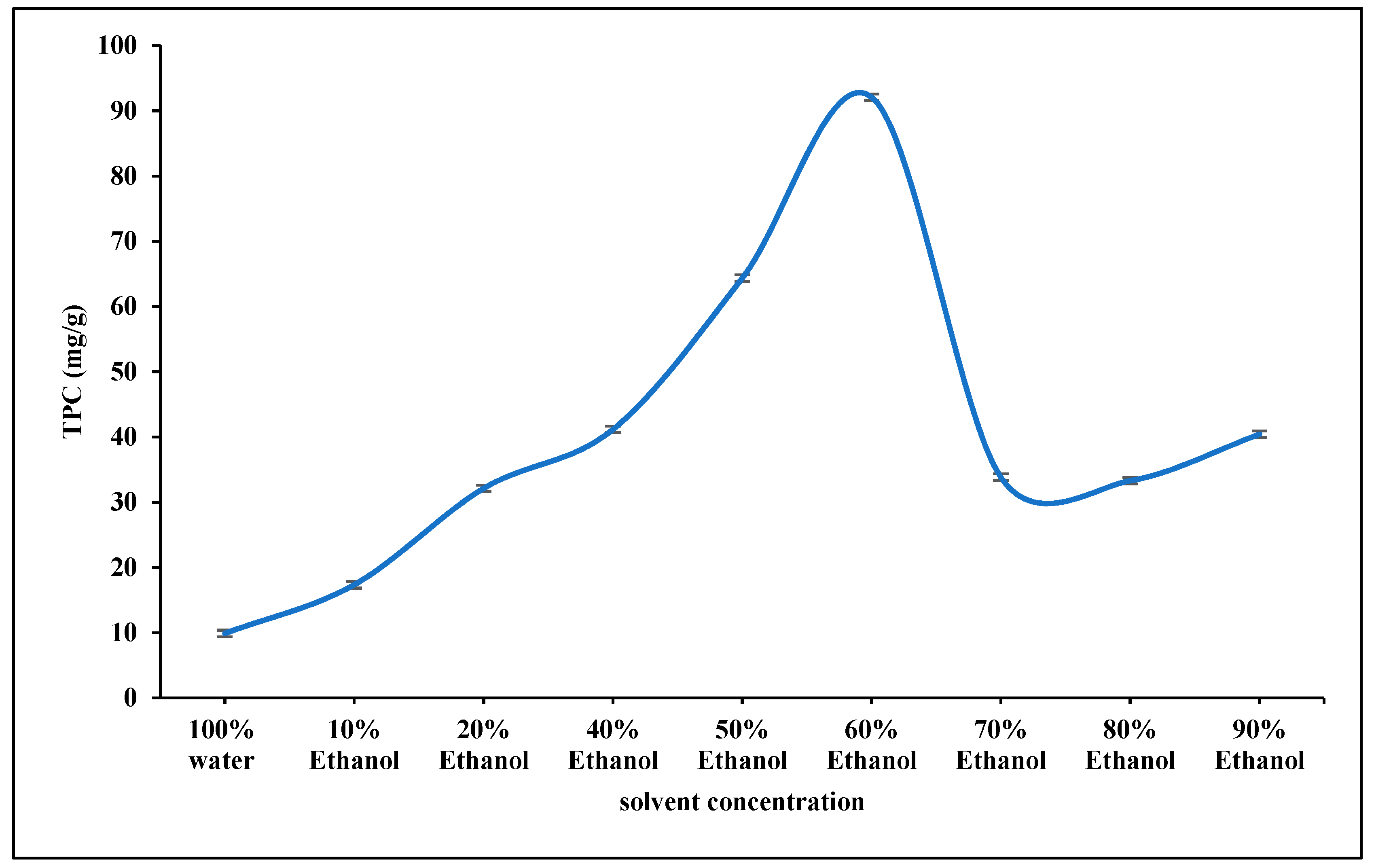

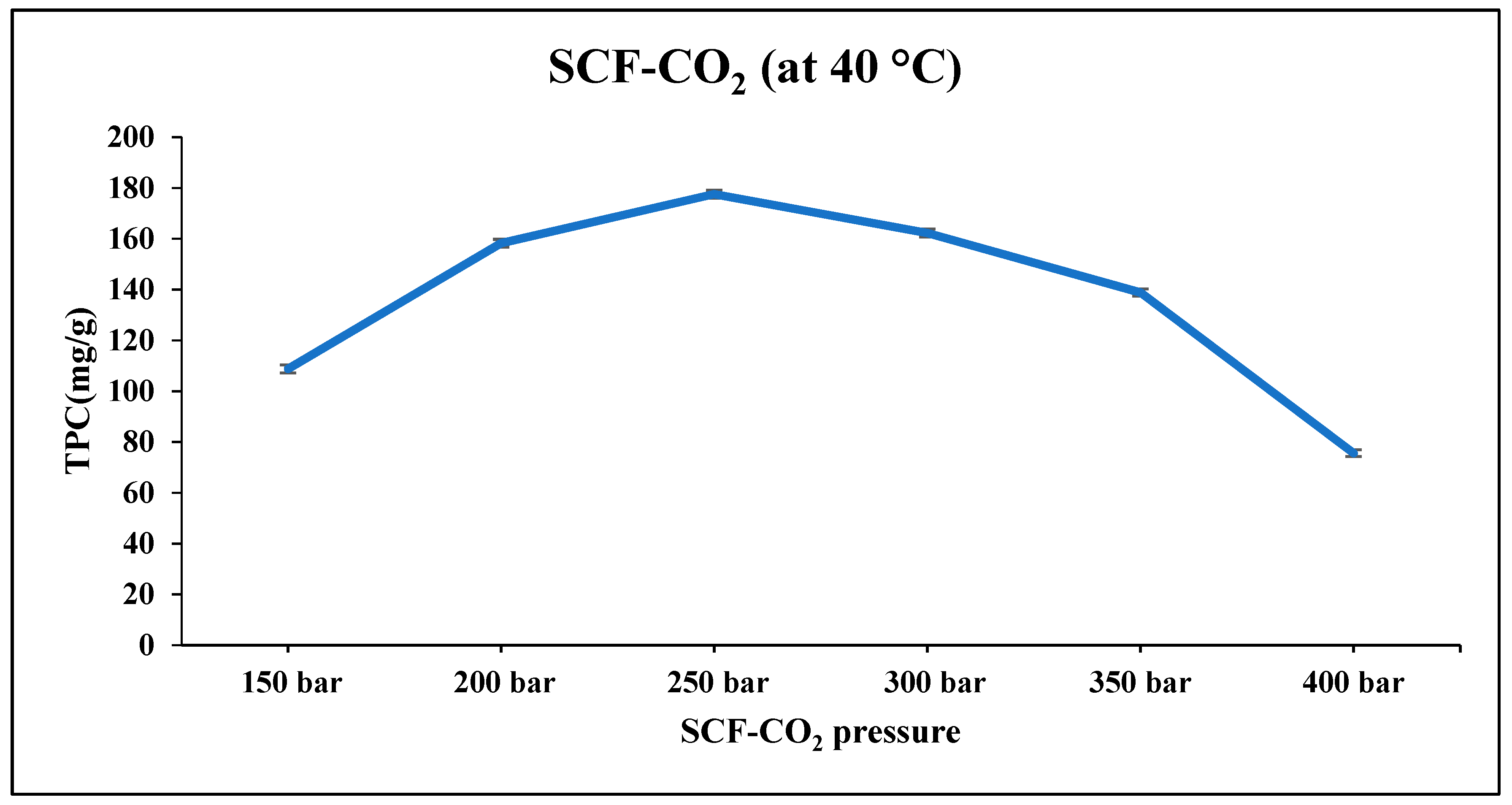
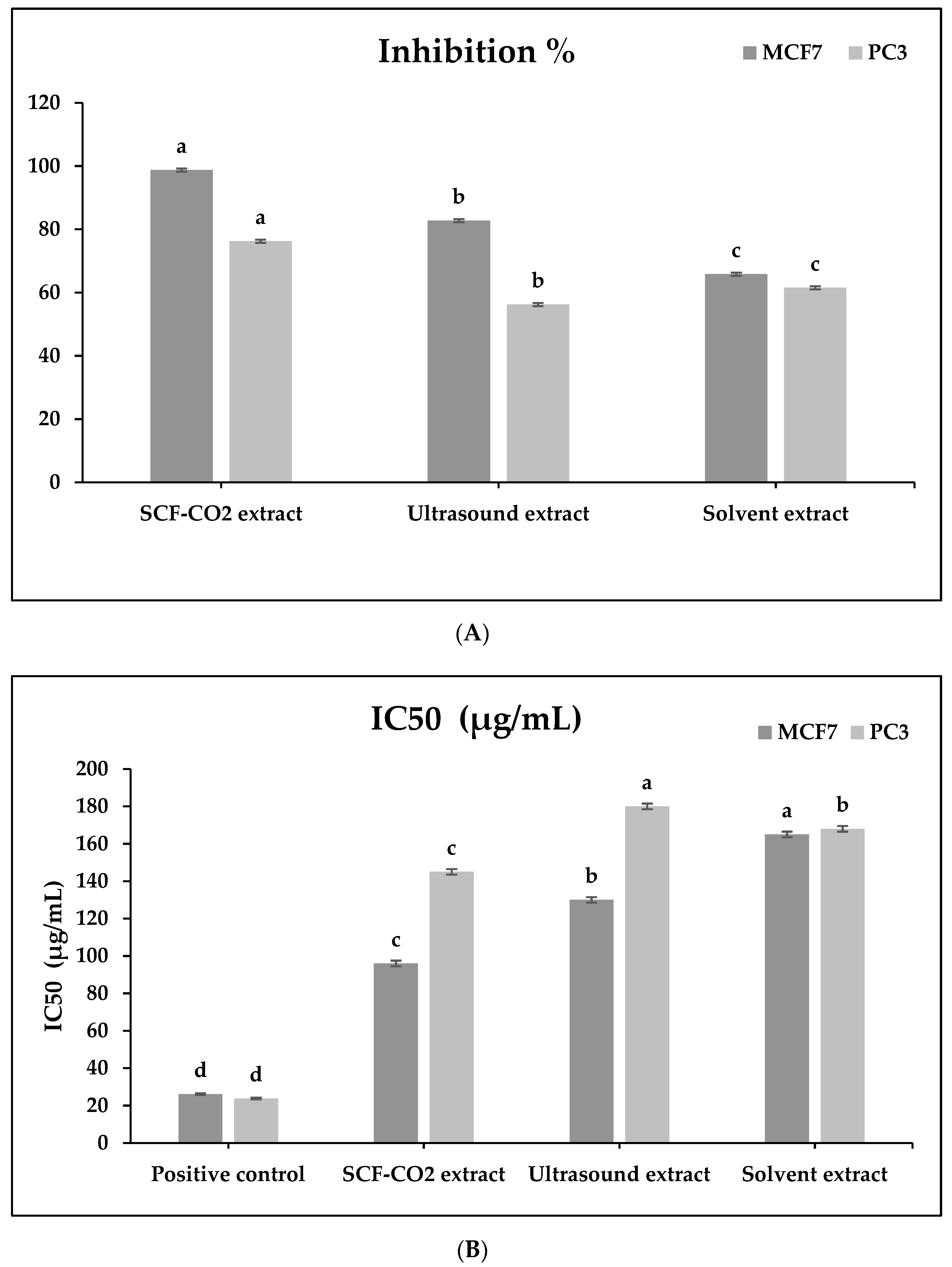

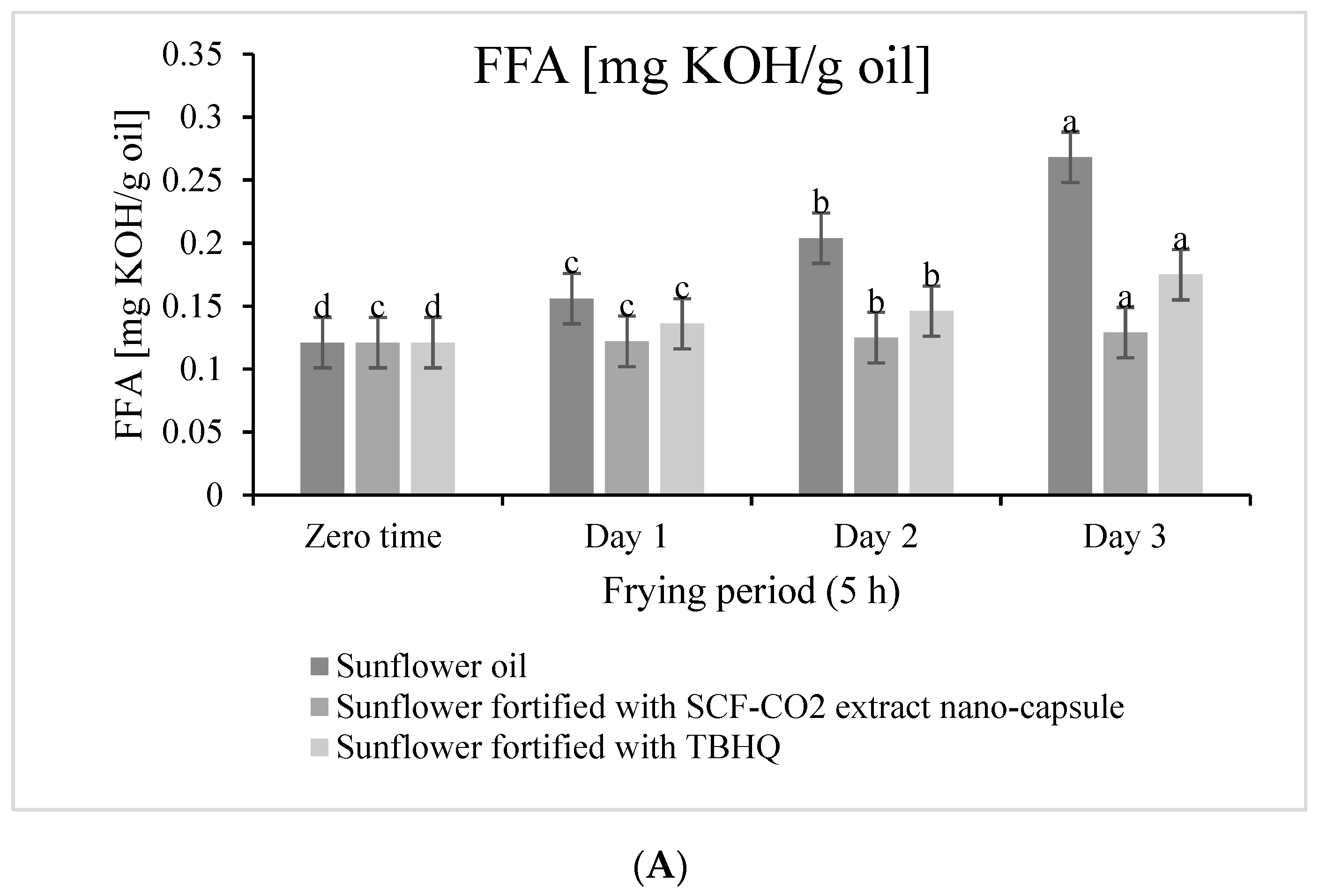
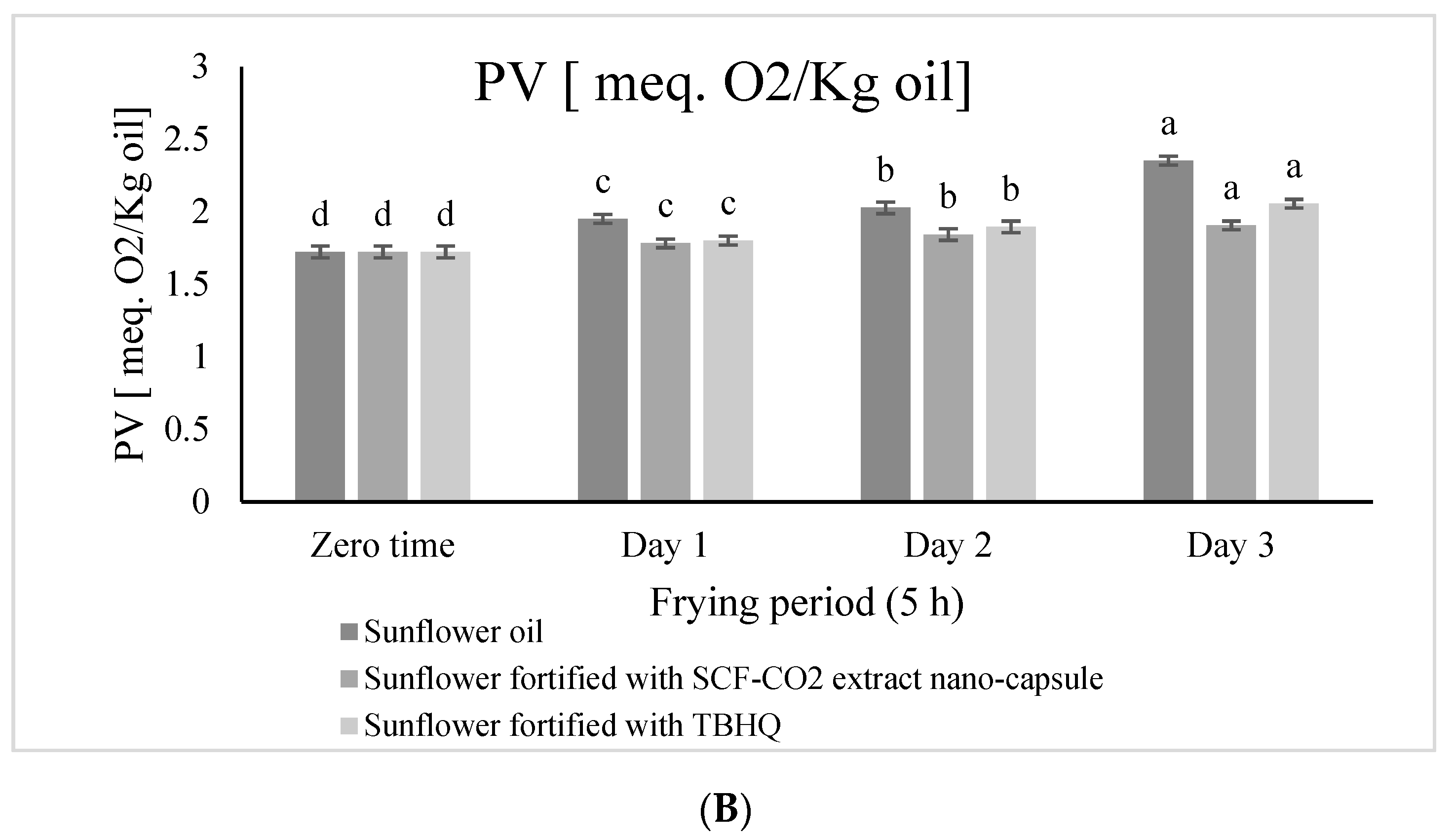
| Run | S-Time * (min) | S-Power * (watt) | TPC (mg/g) |
|---|---|---|---|
| 1 | 3 | 250 | 83.05 ± 0.22 |
| 2 | 10 | 250 | 90.25 ± 0.15 |
| 3 | 5 | 150 | 83.83 ± 0.18 |
| 4 | 17 | 250 | 98.42 ± 0.12 |
| 5 | 5 | 400 | 99.95 ± 0.15 |
| 6 | 10 | 250 | 92.56 ± 0.20 |
| 7 | 10 | 150 | 88.36 ± 0.11 |
| 8 | 15 | 150 | 92.08 ± 0.22 |
| 9 | 3 | 250 | 82.88 ± 0.25 |
| 10 | 10 | 250 | 90.32 ± 0.28 |
| 11 | 15 | 400 | 109.24 ± 0.21 |
| 12 | 10 | 250 | 88.9 ± 0.13 |
| 13 | 10 | 450 | 113.5 ± 0.24 |
| Source | Squares | Df | Square | Value | Prob > F | |
|---|---|---|---|---|---|---|
| Model | 1089.05 | 5 | 217.81 | 141.26 | <0.0001 | significant |
| A-S-Time | 228.20 | 1 | 228.20 | 148.00 | <0.0001 | |
| B-S-power | 162.50 | 1 | 162.50 | 105.39 | <0.0001 | |
| AB | 0.074 | 1 | 0.074 | 0.048 | 0.8332 | |
| A2 | 0.14 | 1 | 0.14 | 0.092 | 0.7703 | |
| B2 | 85.71 | 1 | 85.71 | 55.59 | 0.0001 | |
| Residual | 10.79 | 7 | 1.54 | |||
| Lack of Fit | 3.88 | 3 | 1.29 | 0.75 | 0.5773 | Not significant |
| Pure Error | 6.91 | 4 | 1.73 | |||
| Cor Total | 1099.85 | 12 | ||||
| Std. Dev. | 1.24 | R2 | 0.9902 | |||
| Mean | 93.33 | Adj R2 | 0.9832 | |||
| C.V. % | 1.33 | Pred R2 | 0.9606 | |||
| PRESS | 43.32 | Adeq Precision | 35.282 |
| Treatment | TPC (mg/g) | TFC (mg QE/g) | |
|---|---|---|---|
| Predicted Value | Actual Value | ||
| Ethanol 60% | - | 92.1 | 67.43 |
| Sonication (15 min, 400 watt) | 110.147 | 112.89 | 82.54 |
| SCF-CO2 | - | 177.58 | 139.85 |
| Compounds | Solvent Extraction (mg/kg) | Ultrasound (mg/kg) | SCF-CO2 (mg/kg) |
|---|---|---|---|
| Pyrogallol | 25.23 ± 0.05 b | 16.44 ± 0.04 c | 80.19 ± 0.06 a |
| Gallic acid | - | 19.82 ± 0.03 a | - |
| Catechol | 143.72 ± 0.07 b | 227.16 ± 0.05 a | - |
| p-Hydroxy benzoic acid | 66.63 ± 0.09 c | 124.96 ± 0.07 b | 1981.65 ± 0.04 a |
| Chlorogenic | 1.91 ± 0.03 c | 4.95 ± 0.05 b | 45.81 ± 0.07 a |
| Vanillic acid | 13.48 ± 0.02 c | 53.95 ± 0.02 b | 314.39 ± 0.06 a |
| Syringic acid | 10.08 ± 0.05 c | 26.57 ± 0.03 b | 423.23 ± 0.04 a |
| Benzoic acid | 297.22 ± 0.01 c | 383.09 ± 0.06 b | 5478.37 ± 0.05 a |
| Ferulic acid | 6.14 ± 0.08 c | 8.20 ± 0.05 b | 20.79 ± 0.06 a |
| Rutin | 238.11 ± 0.02 c | 497.16 ± 0.04 b | 4891.56 ± 0.05 a |
| Ellagic | 32.14 ± 0.03 a | 29.56 ± 0.08 b | - |
| o-Coumaric acid | - | - | 18.17 ± 0.07 a |
| Cinnamic acid | - | - | 9.61 ± 0.05 a |
| Quercitin | 1315.75 ± 0.04 c | 2980.92 ± 0.05 b | 50,018.10 ± 0.08 a |
| Rosemarinic | 202.43 ± 0.03 b | 656.39 ± 0.04 a | - |
| Myricetin | 13.78 ± 0.02 c | 19.67 ± 0.02 b | 421.88 ± 0.05 a |
| Kampherol | 23.62 ± 0.01 b | 2.45 ± 0.07 c | 47.51 ± 0.02 a |
Publisher’s Note: MDPI stays neutral with regard to jurisdictional claims in published maps and institutional affiliations. |
© 2022 by the authors. Licensee MDPI, Basel, Switzerland. This article is an open access article distributed under the terms and conditions of the Creative Commons Attribution (CC BY) license (https://creativecommons.org/licenses/by/4.0/).
Share and Cite
Younis, M.I.; Ren, X.; Alzubaidi, A.K.; Mahmoud, K.F.; Altemimi, A.B.; Cacciola, F.; Raza, H.; Pratap-Singh, A.; Abedelmaksoud, T.G. Optimized Green Extraction of Polyphenols from Cassia javanica L. Petals for Their Application in Sunflower Oil: Anticancer and Antioxidant Properties. Molecules 2022, 27, 4329. https://doi.org/10.3390/molecules27144329
Younis MI, Ren X, Alzubaidi AK, Mahmoud KF, Altemimi AB, Cacciola F, Raza H, Pratap-Singh A, Abedelmaksoud TG. Optimized Green Extraction of Polyphenols from Cassia javanica L. Petals for Their Application in Sunflower Oil: Anticancer and Antioxidant Properties. Molecules. 2022; 27(14):4329. https://doi.org/10.3390/molecules27144329
Chicago/Turabian StyleYounis, Mohamed Ibrahim, Xiaofeng Ren, Azalldeen Kazal Alzubaidi, Khaled Fahmy Mahmoud, Ammar B. Altemimi, Francesco Cacciola, Husnain Raza, Anubhav Pratap-Singh, and Tarek Gamal Abedelmaksoud. 2022. "Optimized Green Extraction of Polyphenols from Cassia javanica L. Petals for Their Application in Sunflower Oil: Anticancer and Antioxidant Properties" Molecules 27, no. 14: 4329. https://doi.org/10.3390/molecules27144329
APA StyleYounis, M. I., Ren, X., Alzubaidi, A. K., Mahmoud, K. F., Altemimi, A. B., Cacciola, F., Raza, H., Pratap-Singh, A., & Abedelmaksoud, T. G. (2022). Optimized Green Extraction of Polyphenols from Cassia javanica L. Petals for Their Application in Sunflower Oil: Anticancer and Antioxidant Properties. Molecules, 27(14), 4329. https://doi.org/10.3390/molecules27144329










